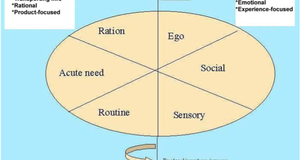From Elon Journal of Undergraduate Research in Communications VOL. 5 NO. 1The Efficacy of Guerrilla Advertising on Public Health Issues
IN THIS ARTICLE
KEYWORDS
AbstractWhile commercial businesses utilize guerrilla advertising regularly nowadays, the practice has crossed over into non-commercial territory: the public health industry. The purpose of this study is to assess the perceived efficacy of guerrilla advertising tactics, specifically as applied to public health issues. Based on fear appeal, sensory involvement, and environmental circumstances, three important components for measuring the efficacy of advertisements, the author created a measurement instrument called the Resonance and Impact Analysis (RIA) Scale that was used to measure three guerrilla-style public health advertisements. The study found that advertisements that incorporated a clear fear appeal and an enclosed environment garnered higher scores on the RIA Scale than those in a more traditional presentation, resulting in a presumed higher impact, resonance, and efficacy with the public. IntroductionIn 2007, the advertising agency Taxi Canada came up with an outdoor media stragegy to advertise McCain Smooth-eez, a pre-made, frozen fruit drink. Taxi Canada created a life-size blender inside revolving glass doors and allowed customers to see all of the ingredients that make up McCain Smooth-eez as they walked through it. This is a perfect example of guerrilla advertising. By placing this unconventional and creative advertisement in an unexpected location and allowing the public to interact with it, McCain Smootheez made good use of guerrilla advertising to increase public awareness, stimulate positive brand image, and drive product purchase. These are advertising techniques that were examined in this article. BackgroundGuerrilla Advertising BackgroundAs a non-traditional form of advertising, guerrilla advertising is a creative, low-cost technique with the possibility of maximum impact on the public. Finding its roots in “guerrilla warfare” tactics that rely on raids and ambush attacks, guerrilla advertising gained momentum after Levinson (1984) outlined a list of tactics on innovative advertising that involves a “small budget, big results” strategy (Hutter and Hoffmann 2). Whereas traditional advertising comprises above-the-line media channels such as television, newspapers, radio, and outdoor posters, guerrilla advertising exists in less traditional channels such as elevators, taxis, the human body, bathroom stalls, etc. (Jurca 4). Taking advantage of public locations, community interactions, and collaborative involvement, guerrilla advertising incorporates unique methods and deliverables to create a truly intriguing advertising experience. These techniques find success with consumers because the consumers are surprised by the unconventional guerrilla action (surprise effect), which leads them to voluntarily diffuse the message because of their unique experience (diffusion effect). Companies and organizations benefit because of these reactions and the flexibility of the unconventional advertising (low-cost effect) (Hutter and Hoffmann 5). Hutter and Hoffmann explain that guerrilla advertising is an umbrella phrase that includes multiple techniques such as ambush, ambient, sensation, buzz and viral advertising (3). For the purpose of this paper, the author used the phrase “guerrilla advertising” exclusively to include all of these techniques. Public Health and Social Marketing BackgroundPublic health, as defined by the Association of Schools of Public Health, is “the science and art of protecting and improving the health of communities through education, promotion of healthy lifestyles, and research for disease and injury prevention” (What is Public Health?). Public health interventions have many purposes, ranging from preventing sexually transmitted diseases, to promoting seat belt use, to providing information and access to birth control (What is Public Health?). Because public health is an industry that is not profit, but rather behavior based, it relies heavily on “social marketing” for message diffusion. The Center for Disease Control and Prevention (CDC), the U.S. Department of Health and Human Services (USDHHS), other governmental agencies, and non-profit organizations have all taken part in social marketing to “design and implement programs to promote socially beneficial behavior change” (Grier and Bryant 319). While there is some debate on the “direct translation of mainstream marketing principles into a social context,” there exists an opportunity for less traditional forms of promotion, such as guerrilla advertising, within the social marketing mix. While the aim of guerilla advertising is typically high returns and profitability for a product, service or brand, its principles and techniques have begun to be used to fulfill the need for stimulating and reactionary public health advertising that truly resonates with the public. The specific public health concepts and their guerrilla advertising techniques examined by this research, include the prevention of drunk driving, the encouragement of sunscreen use to prevent skin cancer, and the discouragement of smoking. Literature ReviewA significant amount of research has been done on guerrilla advertising for consumer marketing. So far, the literature has focused on why guerrilla advertising has been adopted, what kind of emotional appeals were aroused by different ads, and ethical and legal issues this type of advertising involves. Although the concept of guerrilla advertising can be applied to other fields, very little literature exists on the application and effectiveness of guerrilla advertising in non-commercial venues, more specifically, public health matters and initiatives. This research tried to fill this gap by establishing a scale of measurement. This scale, which consists of three subscales on emotional appeals, sensory involvement and environmental circumstances, was created to assess the effectiveness and impact of guerrilla advertising of public health issues. GlobalizationThe conception of guerrilla advertising can be described as an environmental necessity. With a rising uncertainty brought about by globalization in the marketplace and transformations in the media, companies and businesses have found it more and more expedient to stay ahead of the evolving climate and advertise in more unique and unexpected ways. Ay, Aytekin and Nardali (2010) assert that because of economic insecurity, companies have been forced to reconsider their promotional and advertising budgets while trying to maintain and exceed their brand reach, impact, and profitability, resulting in a surge in guerrilla advertising. Bigat (2012) explains that guerrilla advertising offers companies the opportunity to deliver low-cost and innovative advertising strategies in order to gain a powerful competitive edge and react to the changing environment. It is easy to argue that the use of more unique, interactive, and unexpected advertising techniques in an environment of static traditional marketing allows consumers to cut through the clutter, process the message more deeply, and raise the level of interest in a product or brand, as suggested by Razzaq, Ozanne and Fortin (2009). Guerrilla advertising―originally a technique employed by smaller businesses due to the low-costs and the possibility of high returns—has readily been adopted by large corporations as well, creating an even more competitive environment to capture the audience’s attention and influence behavior. While traditional advertising has only a handful of methods from which to choose, guerrilla advertising has a full arsenal of tactics that can reach very specifically targeted audiences, making it a powerful marketing tool, according to Bigat (2012). Emotional AppealsRelying heavily on consumer research and insights, guerrilla advertising typically utilizes emotional appeals to reach its audience as intentionally and appropriately as possible. According to Brown (2009), feelings and emotions always dominate cognition, and this approach has been readily adopted by the advertising industry, resulting in much more emotionally appealing and stimulating advertisements. Lukic (2009) asserts that the three main emotional appeals used within advertising and marketing are fear, guilt, and positive appeals, each of which can be utilized in different circumstances for different purposes. Fear and guilt, for example, might be used to promote either abiding by safety regulations or participating in charity work, according to Lukic (2009). Brown (2009), on the other hand, shows the success that positive appeals had in Dove’s Campaign for True Beauty because it evoked a sense of confidence and optimism from the women it was targeting, and in turn generated more positive feelings toward the brand and its products. The literature has shown some discrepancies about which type of emotional appeal is the strongest because it is highly dependent on the nature of the intended response. Increased product purchasing and positive brand image call for a more positive appeal strategy, whereas a negative-active behavioral change (such as quitting smoking) usually utilizes the fear or guilt appeal according to Brown (2009). While each appeal can find success in different circumstances, Belíc and Jönsson (2012) conclude that it is vital to match the particular appeal with the product type or intended response. ImplicationsThe literature addresses the ethical, societal and legal implications as well. When using fear appeal, it is possible that the experience may be so disturbing that the viewer is left feeling somewhat upset, stressed or anxious (Ay, Ayteki and Nardali 283). It is especially crucial to note that some fear appeal advertisements that target an adult audience may be unintentionally seen by children, resulting in a traumatic experience for the child. Thus, ethical considerations should be taken into account when the fear appeal is employed in advertising. The guilt appeal requires ethical considerations as well, when the guilt or shame ostracizes an individual from the community. For instance, if an advertisement uses a guilt appeal to promote charity work by insinuating the lack of social acceptance and respect for people from their peers if they do not participate, one may consider this an unethical practice because it damages their self confidence and sense of belonging in their community (Lukic 2009). Many legal implications arise from guerrilla marketing due to its non-traditional nature. Guerrilla advertising typically appears in unique locations such as bus stops, sidewalks, near billboards, etc. These tactics are not always done with explicit permission and can lead to fines for illegally defacing the location or property. Bigat (2012) contends that the fines incurred are typically less than what a company might have spent on any other form of traditional advertising such as a billboard, and is therefore a risk the advertiser is willing to take. Social MarketingWhile little research explicitly explores tactical guerrilla advertising for public health and social causes, some scholars have studied general social marketing for various social causes, such as in relation to government agencies, non-profit organizations, and public health initiatives. Social marketing, according to Andreasen, is “the adaptation of commercial marketing technologies to programs designed to influence the voluntary behavior of target audiences to improve their personal welfare and that of the society of which they are a part” (p. 110). Grier and Bryant (2005) explain how public health officials can incorporate social marketing to “facilitate acceptance, rejection, modification, abandonment or maintenance of particular behaviors by target audiences.” This can be applied to various health-centric initiatives that discourage smoking or drunk-driving and encourage suicide prevention or flu shots. Grier and Bryant (2005) go on to discuss that in order to be successful, social marketers consider the psychographics and behaviors of the audience to provide a benefit through the advertisement that they truly value. Further Research OpportunitiesMuch literature discusses guerrilla advertising in commercial and profit-based terms, but there is room to explore how it is being used in conjunction with the intrinsic values of social marketing. Competition in the public health arena is not with another company or business vying for a share of the marketplace, but rather with bad behavioral options to dissuade: driving drunk instead of taking a cab home, not exercising instead of exercising for better health, or not putting on sun screen instead of putting it on to avoid skin cancer. It is here that guerrilla advertising is being employed as a part of a social marketing scheme to influence behaviors and offer the true value of maintaining a healthy lifestyle. Research Question and HypothesisThe research question for this study was how much emotional appeals, sensory involvement and environmental circumstances contribute to the resonance and effectiveness of guerrilla-style advertisements for public health issues and initiatives. It has one hypothesis: Higher levels of fear appeals, sensory involvement, and confining environmental circumstances would lead to the increased impact, resonance and efficacy of guerrilla advertisements for public health issues and initiatives. MethodsThis study analyzed the content of three advertisements that belong to public health guerrilla advertising. The author created a scale called the Resonance and Impact Analysis Scale (RIA Scale), which has three subscales that measure the impact of sensory involvement, emotional appeals, and environmental circumstances each on advertisements. Subscale of Fear AppealAccording to various research studies, emotions play a large part in the effectiveness of advertising. According to Brown, fear appeal can be particularly effective to change consumer behavior (5). While a fear appeal can face ethical implications for consumer products due to negative reactions and brand perception, its employment with public health initiatives is well founded. Lukic describes fear appeal as “threatening the audience with harmful outcomes from initiating or continuing an unhealthy practice,” which is especially relevant in encouraging public health initiatives. (28). In the commercial arena, the fear of not having the coolest car is marginal. In the public health arena, on the other hand, the fear of developing lung cancer from smoking cigarettes is much more dire and life threatening. This rational and impending fear of lung cancer, for example, is the kind that can be capitalized on in advertising for the good of the society and individuals. Ay, Ayteki, and Nardali (2010) assert that the emotional response following a fear appeal is anxiety or stress. By providing relief to this fear, whether through implying a solution or debriefing the audience after the experience, this stress or anxiety is relieved. It is when these emotions go unalleviated that an advertisement may be considered unethical or irresponsible, according to Ay, Ayteki, and Nardali (2010). Based on Rogers’ Protection Motivation Theory, Boer and Seydel describe a linear relationship between fear-appeal communications and behavioral responses in their study (96). The fear is aroused, the severity of its consequences is appraised, and then the efficacy of the proposed solution is considered to be either adopted or dismissed. Boer and Seydel go on to explain that the higher the fear level and perceived consequences are, the higher the likelihood that the audience would adopt the proposed solutions. Based on the above model, the fear appeal scale was created with three questions: whether an ad arouses a fear appeal, whether the consequences of the fear or behavior are extreme after a fear is aroused; and whether the proposed solution can be easily and immediately adopted. The word “extreme” in the second question means that the consequences are life threatening, socially ostracizing, illegal, or highly unethical. A positive response to each question garners one point, so the fear appeal score on this scale can range from 0 to 3.Continued on Next Page » Suggested Reading from Inquiries Journal
Inquiries Journal provides undergraduate and graduate students around the world a platform for the wide dissemination of academic work over a range of core disciplines. Representing the work of students from hundreds of institutions around the globe, Inquiries Journal's large database of academic articles is completely free. Learn more | Blog | Submit Latest in Business & Communications |
























